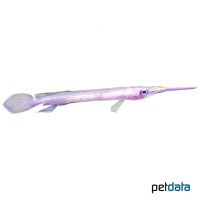Forest Halfbeak (Hemirhamphodon pogonognathus)
| Forest Halfbeak Hemirhamphodon pogonognathus | |
|---|---|
| Name | Forest Halfbeak |
| Name Lat. | Hemirhamphodon pogonognathus |
| Synonym | Hemirhamphus pogonognathus |
| Family | Viviparous Halfbeaks |
| Family lat. | Zenarchopteridae |
| Order | Needle Fishes |
| Order lat. | Beloniformes |
| Origin | Southeast Asia |
| Habitat | Forest streams, ponds |
| Diet | Carnivore |
| pH | 6.0-7.5 |
| Behavior | ♂ territorial |
| Keeping | Harem |
| Care Level | Experts only |
| Reproduction | Livebearer |
| Breeding | Moderately difficult |
| Life Span | 3-4 years |
| Protection | No |
| Metric Units | |
| Size | 8-10 cm |
| Temperature | 24-28 °C |
| Hardness | 5-10 °dH |
| Aquarium | 200 l |
| US Units | |
| Size | 3.1"-3.9" |
| Temperature | 75-82 °F |
| Hardness | 89-178 ppm |
| Aquarium | 50 gal |
Distribution and habitat
Tooth-billed half-bills are found in southern Thailand and the Malay Peninsula, as well as Sumatra and Borneo. They live in slow-flowing, shaded forest streams and ponds, often with dense submerged vegetation, where they stay on the water surface to forage.
Maintenance
The aquarium should have a varied, partly dense edge planting, with shelters and hiding places (roots) and provide sufficient swimming space. A dark substrate covered with some foliage (sea almond tree, beech) and slightly shaded light (floating plants) is ideal.
No ammonia, ammonium and nitrite should be detectable, the nitrate value should not exceed 100 mg/l. To ensure the water quality and oxygen content, a filter and heater adapted to the aquarium size is required, as well as lighting for the species-appropriate day-night rhythm of the animals.
Diet
They prefer to eat approach food (mosquitoes, etc.) from the water surface. The food supply consists of live, frozen and dry food. For a balanced diet, feed at least once a day with a high-quality dry food (flakes, granules, pellets) as well as cyclops, daphnia or mosquito larvae (live or frozen). Aphids, fruit flies and fruit flies are also readily eaten. No food is taken from the bottom
Only feed as much as will be eaten within a few minutes. A regular and varied diet promotes health and increases resistance.
Behaviour and compatibility
They are peaceful fish that are best kept in a harem, one male with several females. Males form small territories and are very quarrelsome within the species. Multiple males should only be kept together in a larger and richly structured aquarium. They can be socialized very well with other small, peaceful and calm, but not surface-oriented fish. Basically, only mutually compatible fish species with similar water condition and water temperature requirements should be socialized.
Sex dimorphism
The much larger males have a dark spot on the gill cover and an anal fin (andropodium) converted to a mating organ. The smaller females appear more rounded.
Reproduction and breeding
Tooth-billed half-bills are live-bearing fish. Internal fertilization is provided by the male's gonopodium. After 6-8 weeks of gestation, 1-5 fry are born daily, over a period of 2-3 weeks. They are fully developed at birth and can immediately begin feeding on their own.
Fry must be fed several times a day with special rearing food (e.g. Artemia nauplii). In community tanks breeding is hardly possible, because the fry are easy prey.
Important
A gapless cover is necessary, because the jumpy animals can jump well.
The foliage (sea almond tree, beech, oak, etc.) enriches the water with humic substances and naturally lowers the pH
The well-being of the fish should be checked regularly. The temperature should be checked daily, the pH, hardness and nitrate value at least every 14 days. Regular partial water changes are recommended, even if the contaminant level has not yet reached the upper limit. Sudden changes in water quality should be avoided. Newly introduced fish must be accustomed slowly to the water in the aquarium.
Further literature can be found in your pet store.
References
Text: Werner Winter; Image: petdata
Source: BMELV (1998): Tierschutzgutachten - Haltung von Zierfischen (Süßwasser); BAENSCH & RIEHL (2006): Aquarien Atlas Bd. 2, Mergus Verlag; ENGELMANN (2005): Zootierhaltung - Tiere in menschlicher Obhut: Fische, Verlag Harri Deutsch
- Gemäß § 21 Abs. 5 Tierschutzgesetz idgF
